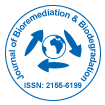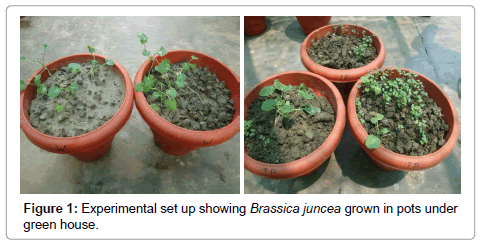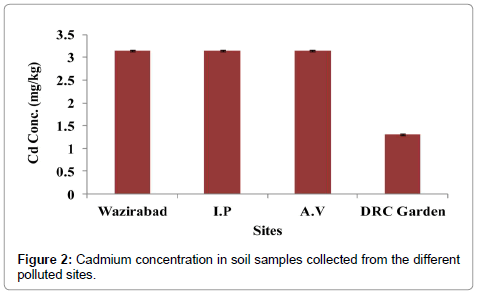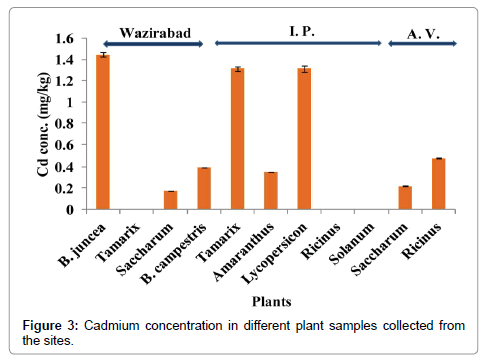Research Article Open Access
Phytoremediation of Cadmium from Polluted Soil
Rekha Kathal1, Priti Malhotra2 and Vidhi Chaudhary1*
1Department of Botany, Daulat Ram College, University of Delhi, New Delhi, India
2Department of Chemistry, Daulat Ram College, University of Delhi, New Delhi, India
- *Corresponding Author:
- Dr Vidhi Chaudhary
Department of Botany, Daulat Ram College
University of Delhi, Delhi, India
Tel: 09871967002
E-mail: msvidushi17@gmail.com
Received date: July 12, 2016; Accepted date: November 15, 2016; Published date: November 18, 2016
Citation: Kathal R, Malhotra P, Chaudhary V (2016) Phytoremediation of Cadmium from Polluted Soil. J Bioremediat Biodegrad 7:376. doi: 10.4172/2155-6199.1000376
Copyright: © 2016 Kathal R, et al. This is an open-a ccess article distributed under the terms of the Creative Commons Attribution License, which permits unrestricted use, distribution, and reproduction in any medium, provided the original author and source are credited.
Visit for more related articles at Journal of Bioremediation & Biodegradation
Abstract
An increase in the concentrations of heavy metals in the environment from year to year has become a serious environmental concern. Technology development, anthropogenic and industrial activities lead to emission of heavy metals and their accumulation in ecosystem. Heavy metals such as Cadmium (Cd), Cobalt (Co), Lead (Pb) and Mercury (Hg) are toxic to organisms. Due to their non-degradable and persistence in nature, these elements cause serious health problems in human beings and animals through food chain. Therefore, the cleanup of contaminated sites is mandatory for the removal of these potentially damaging substances from soil and water. Although several engineering based methods are already being used to remediate metal contaminated soils but they destroy the biotic components of soil, causes secondary pollution and are expensive to implement. In contrast, Phytoremediation has emerged out as a low cost effective, environment friendly technology in which plants and their associated microbial flora are used to remediate metal ions from polluted areas. In the present study, an attempt has been made to remediate Cadmium concentration from the polluted soil with the help of plant. Cadmium is one of the most toxic elements, which affect the kidney, bones and lungs of human beings. In the present study, soil and plant samples were collected from the different locations containing industrial wastes and tested for cadmium concentration using Atomic Absorption Spectrophotometry (AAS). A significant decline in Cd concentration was observed in pot soil, in which Brassica juncea was grown under green house conditions. Furthermore, higher concentration of Cd concentration in the harvested plant as compared to the seeds, justify the ability of B. juncea to remediate toxic Cd and control soil pollution.
Keywords
Heavy metals; Cadmium; Phytoremediation; Atomic Absorption Spectrophotometry; Brassica juncea
Introduction
Heavy metals can be divided into two categories: essential and non-essential on the basis of their role in living systems. Essential heavy metals such as Mn, Fe, Ni, Zn are needed by living organisms for their growth, development and physiological functions [1] while non-essential heavy metals such as Cd, Pb, Hg and As are not needed by living organisms for any physiological function [2]. The sources of heavy metal contamination include industrial effluents, mining, smelting, application of pesticides and disposal of municipal wastage. At higher concentrations, these metals interfere with physiological, biochemical and molecular processes of living systems [3]. These toxic substances pose serious risk to human beings, animals and environment, by contaminating food chain through bioaccumulation and biomagnification [4]. These metals pose a great potential threat to the natural resources such as soil and water, due to their nondegradable and persistence nature in the environment.
Currently, conventional remediation methods including physical and chemical methods have been used for remediation of heavy metals but they are environmentally destructive, highly expensive and difficult to implement. Several reports have been published focusing on bioremediation of heavy metals using biological material such as living plants or microbes from polluted soil and water. Phytoremediation, a fast emerging technology is an ecofriendly, low tech, cost effective, green alternative to the problem [5]. The specific plant and wild species that are used in this technique accumulate increasing amounts of toxic heavy metals by their roots and transport/translocate them through various plant tissues where they can be metabolized, sequestered and volatilized [6,7]. These plants are known as hyper accumulators. Phytoremediation can be done by different ways such as rhizofiltration, phytostabilization, phytovolatilization, phytodegradation [8] and phytoextraction [9].
Cadmium is an extremely toxic metal, commonly found in industrial workplaces related to metal plating, batteries, paint pigments, plastic stabilizers, photographic chemicals etc. It is one of the more mobile heavy metals in soil-plant system, easily taken up by plants primarily through roots, accumulate in plants and with no essential function known to date [10,11]. Cadmium causes different toxic effects [12]. It affects the plant by inhibiting oxidative reactions and nitrogen metabolism. Presence of cadmium in plants causes water shortage, ionic imbalance, chlorosis, necrosis and ultimately cause cell death, growth inhibition and yield reduction. Consumption of food is the most common route for the exposure of cadmium in human beings. It affects central nervous system, immune system, reproductive system, lungs, kidneys and bones. High exposure can lead to lung and prostrate cancer. Therefore, the present study was aimed to control Cadmium (Cd) concentration from the polluted soil by phytoremediation.
Material and Methods
Site characterization and sample collection
The soil and plant samples were collected from three polluted sites of Delhi. Sampling was done at Wazirabad Industrial Area (WB), Ashok Vihar Industrial Area (AV) and Indraprastha Power Station (IP). The plants selected for experimental study from these sites were Brassica juncea, Tamarix, Saccharum, Brassica campestris (from WB), Tamarix, Amaranthus, Lycopersicon, Ricinus, Solanum (from AV), Saccharum and Ricinus (from IP). The soil samples were also collected from Daulat Ram College Botanical Garden (DRC) and Delhi University (DU) for comparative study.
Preliminary sample treatment
Collected plants were rinsed thoroughly in water before kept for drying in blotting sheets. Both plant and soil samples were dried in an oven at 60°C for three days. Dried soil was sieved through 0.2 mm size sieves, prior to processing for digestion.
Plant and soil digestion
The process of digestion was carried out in closed system. 2 g of plant and 0.5 g of soil were weighed for digestion. The samples were treated with concentrated HNO3 and HCl (6:1, v/v) [6], heated up at 300°C for 45 minutes by microwave to digest samples and evaporate solvent, followed by cooling at room temperature (24 ± 2°C). The final volume was made up to 25 mL by diluting the digested samples with Milli-Q water.
Plant and soil analysis
The digested soil and plant samples were analyzed to find Cd concentration using Atomic Absorption Spectrophotometer (AAS) [13].
Cadmium concentration was calculated by using the following formula:

Greenhouse experiment
The plant B. juncea was chosen for green house experiment. The seeds were sown in labelled pots of different soil samples. The pots were kept in greenhouse and their growth was monitored regularly (Figure 1). After eight weeks, when the plants reached a height of approximately 12-15 cm, they were uprooted intact. The soil from pots of different sites was taken to analyze the amount of Cd concentration. Cadmium concentration was tested in seeds, harvested plants and the pot soil by Atomic absorption spectrophotometer. The readings were taken in triplicates.
Results and Discussion
Results obtained from the study clearly indicated the successful phytoremediation of Cd from the soil with the help of plant B. juncea. As the bioavailability of heavy metal is important for its remediation, the Cd concentration was checked in soil samples of all selected sites. The results showed the presence of Cd in soil samples of all the sites (Figure 2). The Cd concentration was similar in soil samples of Wazirabad, I. P. and A. V. The soil of control treatment i.e., DRC Garden recorded the lowest Cd concentration, being 1.31 mg/kg (Figure 2). Significant uptake of Cd was observed in the plants i. e., Saccharum spp., Solanum spp., B. juncea and Lycopersicon spp., (Figure 3). The highest concentration of 1.445 mg/kg of Cd was found in B. juncea, followed by 1.313 mg/kg of Cd in Tamarix and Lycopersicon spp., (Figure 3). The success rate of this plant based technology is dependent upon proper plant selection. Results of plant samples collected and analyzed by AAS for Cd content clearly indicate the differential uptake depending upon the plant species. Plants used for phytoextraction must be fast growing, high biomass accumulator, more adaptable to environmental stress and possess the ability to accumulate large amount of heavy metals [14]. B. juncea prove to be a good accumulator used in phytoremediation because of its fast growth, rapid reproduction and high tolerance to metals and climatic conditions. Therefore, B. juncea was selected for further green house experiment. More than 60% reduction was observed in Cd concentration in pot soil, after phytoremediation treatment by B. juncea (Table 1). The highest reduction in the Cd content was observed in I. P. and A. V., followed by DU nursery soil (Table 1). It clearly indicates the phytoextraction of Cd from the soil. A significant increase in Cd concentration in harvested B. juncea plants, compared to seeds proves the phytoextraction and it clearly suggests the uptake of cadmium in plant from soil (Table 2).
| Sites | Cadmium Concentration in soil (mg/kg) | |
|---|---|---|
| Before treatment | After treatment | |
| Initial concentration | Final concentration | |
| Wazirabad | 3.15 ± 0.10 | 3.0 ± 0.11 |
| I. P. | 3.15 ± 0.11 | 0.03 ± 0.00 |
| A. V. | 3.15 ± 0.15 | 0.04 ± 0.00 |
| DRC Garden | 1.32 ± 0.02 | 0.50 ± 0.01 |
| DU Nursery | 4.0 ± 0.12 | 1.50 ± 0.01 |
Table 1: Concentration of Cadmium (Cd) in soil samples of different sites before and after phytoremediation treatment by Brassica juncea.
| Metal | Cadmium concentration (mg/kg) in | |
|---|---|---|
| Seeds of B. juncea | harvested plants of B. juncea | |
| Cd | 0.0 ± 0.0 | 5.98 ± 0.1 |
Table 2: Cadmium concentration in the seeds and harvested plants of Brassica junceagrown in the Delhi University nursery soil (DU).
The results of the study showed that B. juncea proved to be an excellent plant for phytoextraction of Cd from the soil. It can prove as a remedy for controlling heavy metal soil pollution. Similar results were reported by [15]. Selection of plant used as hyperaccumulator play an important role in phytoremediation.
The success rate of this plant based technology as an environmental cleanup technology is highly variable as it depends on several factors including bioavailability of metals in soil, plant's ability to uptake, translocate and accumulate metals in shoots and plant microbe interactions [16]. Moreover its application also depends upon climate, temperature, soil type, texture, plant species, exposure duration, temperature and pH [17]. Since last decade, phytoremediation has gained acceptance as a technology but the basic processes such as biological mechanisms of plant decontamination processes are still largely not clear and hence require further basic and applied research to optimize its field performance. Improvement of plants by genetic engineering and application of transgenic plants opens up new possibilities of phytoremediation. The identification of unique genes from natural hyperaccumulators and their subsequent transfer to fast growing species is another promising approach.
Conclusion
Phytoremediation is a potent sustainable approach for detoxifying the contaminated soil with inorganic pollutants. Heavy metals can be removed from the soil and no disposable sites are required. Extracted metals can be further recycled from the contaminated plant biomass where it is supposed to be useful. It leaves the soil fertile and has less adverse environmental effects as compared to conventional procedures. The most important requirement for phytoremediation work is the proper handling and safe disposal of hazardous waste and harvested plant biomass so that the recycling of heavy metals can be done, wherever it can be used.
Present study on phytoremediation clearly revealed that toxic level of Cd can be controlled significantly by growing B. juncea on the polluted soil. B. juncea acted as good accumulator of heavy metal, therefore remediated Cd from the polluted soil by phytoextraction.
Acknowledgments
The authors are grateful to the University of Delhi (Innovation Project) for providing financial support under innovation project.
References
- Gohre V, Paszkowski U (2006) Contribution of the arbuscular mycorrhizal symbiosis to heavy metal phytoremediation. Planta 223: 1115-1122.
- Peng KJ, Luo CL, Chen YH, Wang GP, Li XD, et al. (2009) Cadmium and other metal uptake by Lobelia chinensis and Solanum nigrum from contaminated soils. Environ ContamTox 83: 260-264.
- Subhashini V, Swamy AVVS (2013) Phytoremediation of Cadmium and chromium from contaminated soils using Physalis minima Linn. Am Int J Res Form Appl Nat Sci 3: 119-122.
- Gustav R (1974) Hazardous heavy metals: Cadmium, Mercury, Lead and Arsenic. WHO International Reference Centre for Waste Disposal, IRCWD News,Switzerland, pp:1-11.
- Meagher RB, Rugh CL, Kandasamy MK, Gragson G, Wang NJ (2000) Engineered phytoremediation of mercury pollution in soil and water using bacterial genes. In: Terry N, Banuelos G (eds.) Phytoremediation of contaminated soil and water. Lewis Publishers, Boca Raton, USA, pp: 201-221.
- Greenberg BM, Hunag XD, Gurska Y, Gerhardt KE, Wang W, et al. (2006) Successful field tests of a multiprocess phytoremediation system for decontaminationofpersistent petroleum and organic contaminants. Proceedings of the twenty ninth Artic and marine oil spill program (AMOP),Canada,pp: 389-400.
- Doty SL, Shang QT, Wilson AM, Moore AL, Newman LA, et al. (2000) Enhanced metabolism of halogenated hydrocarbons in transgenic plants contain mammalian cytochrome P450 2E1. Proceedings of National Academic Science, USA 97: 6287-6291.
- Long X, Yang X, Ni W (2002) Current situation and prospect on the remediation of soils contaminated by heavy metals. J ApplEcol 13: 757-762.
- Jadia CD, Fulekar MH (2009) Phytoremediation of heavy metals: Recent Techniques. Afr J Biotechnol 8: 921-928.
- Lehoczky E, Marth P, Szabados I, Palkovics M, Lukacs P (2000) Applications in food quality and environmental contamination: Influence of soil factors on the accumulation of cadmium by lettuce. Commun Soil Sci Plant Anal 31: 2425-2431.
- Lehoczky E, Szabo L, Horvath S (1998) Cadmium uptake by lettuce in different soils. Commun Soil Sci Plant Anal 29: 1903-1912.
- Sharma A, Sachdeva S (2015) Cadmium toxicity and its phytoremediation A review. International Journal of Scientific and Engineering Research 6: 395-405.
- Mohammed SS, Batu MA, Mohammed MB (2012) Analysis of Cr in Dumpsite Soil Samples Using AAS and EDXRF Techniques. Res J Chem Sci 2: 65-68.
- Moosavi SG, Seghatoleslami MJ (2013) Phytoremediation: A Review. AdvAgriBiol 1: 5-11.
- Bluskov S, Arocena JM, Omotoso OO, Young JP (2005) Uptake, distribution and speciation of chromium in Brassica juncea. Int J Phytoremediation 7: 153-165.
- Hooda V (2007) Phytoremediation of toxic metals from soil and waste water. J Environ Biol 28: 367-376.
- Tangahu BV, Abdullah SRS, Basri H, Idris M, Anuar N, et al. (2011) A review on heavy metals (As, Pb, and Hg) uptake by plants through phytoremediation. Int J ChemEng 21: 1-31.
Relevant Topics
- Anaerobic Biodegradation
- Biodegradable Balloons
- Biodegradable Confetti
- Biodegradable Diapers
- Biodegradable Plastics
- Biodegradable Sunscreen
- Biodegradation
- Bioremediation Bacteria
- Bioremediation Oil Spills
- Bioremediation Plants
- Bioremediation Products
- Ex Situ Bioremediation
- Heavy Metal Bioremediation
- In Situ Bioremediation
- Mycoremediation
- Non Biodegradable
- Phytoremediation
- Sewage Water Treatment
- Soil Bioremediation
- Types of Upwelling
- Waste Degredation
- Xenobiotics
Recommended Journals
Article Tools
Article Usage
- Total views: 15277
- [From(publication date):
November-2016 - Apr 03, 2025] - Breakdown by view type
- HTML page views : 13917
- PDF downloads : 1360



